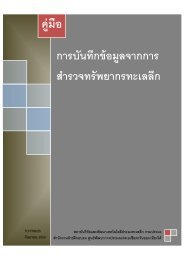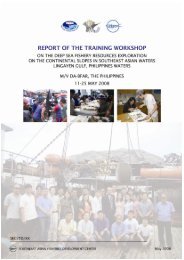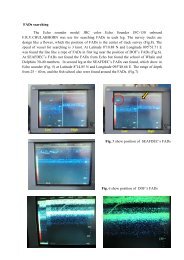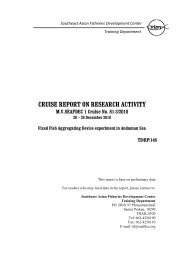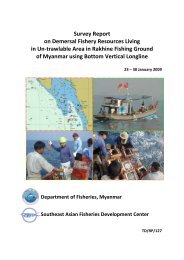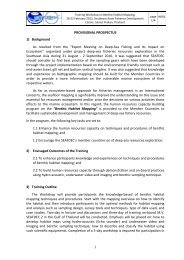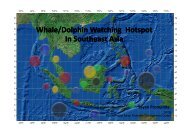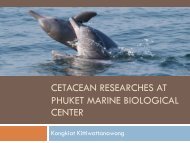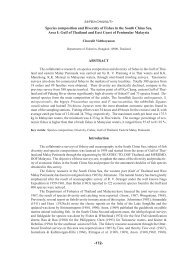the preliminary report on fishery resources exploration ... - SEAFDEC
the preliminary report on fishery resources exploration ... - SEAFDEC
the preliminary report on fishery resources exploration ... - SEAFDEC
- No tags were found...
You also want an ePaper? Increase the reach of your titles
YUMPU automatically turns print PDFs into web optimized ePapers that Google loves.
2008THE PRELIMINARY REPORT ONFISHERY RESOURCES EXPLORATION ONTHE CONTINENTAL SLOPES IN THELINGAYEN GULF, THE PHILIPPINESM/V DA-BFAR, The Philippines11-25 May 2008-25 May 2008SOUTHEAST ASIAN FISHERIES DEVELOPMENT CENTERTD/RES/127
M E S S A G ELike many fishing nati<strong>on</strong>s, <str<strong>on</strong>g>the</str<strong>on</strong>g> Philippines struggles with sustaining fisheriesin traditi<strong>on</strong>al fishing grounds especially in <str<strong>on</strong>g>the</str<strong>on</strong>g> coastal and nearshore waters wheremany of our fishermen depend for <str<strong>on</strong>g>the</str<strong>on</strong>g>ir livelihood and income. While it is wellrecognized that <str<strong>on</strong>g>the</str<strong>on</strong>g> level of fishing needs to be moderated in <str<strong>on</strong>g>the</str<strong>on</strong>g>se areas, alternativelivelihoods and substitute fishing areas are important in achieving <str<strong>on</strong>g>the</str<strong>on</strong>g> objective ofsustainable use of fisheries <strong>resources</strong>.It is for this reas<strong>on</strong> that our initiative to assess <str<strong>on</strong>g>the</str<strong>on</strong>g> potential of our deep sea<strong>resources</strong> is important in optimizing <str<strong>on</strong>g>the</str<strong>on</strong>g> use of available <strong>resources</strong> in deep sea areas.It is ir<strong>on</strong>ic that in <str<strong>on</strong>g>the</str<strong>on</strong>g> Philippines, while 88% of our marine waters are c<strong>on</strong>sidereddeep water z<strong>on</strong>es, yet we do not know much about <str<strong>on</strong>g>the</str<strong>on</strong>g>ir potentials. Neighboringcountries like Taiwan, Japan and o<str<strong>on</strong>g>the</str<strong>on</strong>g>r more advanced fishing countries withrelatively limited deep water areas have developed fisheries that are based <strong>on</strong> deepsea fish species.It is in this light that I recognize <str<strong>on</strong>g>the</str<strong>on</strong>g> value of this collaborative survey betweenBFAR and <strong>SEAFDEC</strong> <strong>on</strong> “Deep Sea Fisheries Assessment Al<strong>on</strong>g <str<strong>on</strong>g>the</str<strong>on</strong>g> C<strong>on</strong>tinentalSlopes of Lingayen Gulf.” The survey resulted with interesting findings particularly<str<strong>on</strong>g>the</str<strong>on</strong>g> presence of deep sea shrimp species that are potentially valuable to fisheries.However, as we put forward our interest and efforts in developing <str<strong>on</strong>g>the</str<strong>on</strong>g> deep sea<strong>resources</strong>, we should also be cognizant with <str<strong>on</strong>g>the</str<strong>on</strong>g> high vulnerability of <str<strong>on</strong>g>the</str<strong>on</strong>g> <strong>resources</strong> tooverexploitati<strong>on</strong>.This endeavor yet again highlighted <str<strong>on</strong>g>the</str<strong>on</strong>g> importance of collaborati<strong>on</strong> betweenBFAR, <strong>SEAFDEC</strong> and its member countries in addressing fisheries matters that areof comm<strong>on</strong> interest in <str<strong>on</strong>g>the</str<strong>on</strong>g> regi<strong>on</strong>.BFAR DirectorAnd <strong>SEAFDEC</strong> Council Director for <str<strong>on</strong>g>the</str<strong>on</strong>g> Philippinesii
FORWARDIn <str<strong>on</strong>g>the</str<strong>on</strong>g> point of view of <strong>fishery</strong> policy maker or government searching of new fishingground as a c<strong>on</strong>sequence of <str<strong>on</strong>g>the</str<strong>on</strong>g> depleti<strong>on</strong> of <str<strong>on</strong>g>the</str<strong>on</strong>g> inshore/coastal fisheries <strong>resources</strong> in <str<strong>on</strong>g>the</str<strong>on</strong>g>Sou<str<strong>on</strong>g>the</str<strong>on</strong>g>ast Asian Countries. Those depleti<strong>on</strong> was also reduces <str<strong>on</strong>g>the</str<strong>on</strong>g> supply of sea foodmaterials to many fish processing industries in <str<strong>on</strong>g>the</str<strong>on</strong>g> regi<strong>on</strong> and reduces <str<strong>on</strong>g>the</str<strong>on</strong>g> food supply for <str<strong>on</strong>g>the</str<strong>on</strong>g>global level. Therefore, <str<strong>on</strong>g>the</str<strong>on</strong>g> deep-sea sea <strong>fishery</strong> <strong>resources</strong> survey in <str<strong>on</strong>g>the</str<strong>on</strong>g> EEZ of <str<strong>on</strong>g>the</str<strong>on</strong>g>Sou<str<strong>on</strong>g>the</str<strong>on</strong>g>ast Asian Regi<strong>on</strong> in order to investigate <str<strong>on</strong>g>the</str<strong>on</strong>g> status and potential were existed.Though <str<strong>on</strong>g>the</str<strong>on</strong>g>re is a great c<strong>on</strong>tinental shelf of almost 50% occupies <str<strong>on</strong>g>the</str<strong>on</strong>g> area of SouthChina Sea, <str<strong>on</strong>g>the</str<strong>on</strong>g> c<strong>on</strong>tinental slope and <str<strong>on</strong>g>the</str<strong>on</strong>g> deep basin down to nearly 1,000 to 5,000 m are <str<strong>on</strong>g>the</str<strong>on</strong>g>largest habitat around <str<strong>on</strong>g>the</str<strong>on</strong>g> Philippines, Taiwan, Ind<strong>on</strong>esia, and part of <str<strong>on</strong>g>the</str<strong>on</strong>g> Andaman Seaareas of Thai and Myanmar Waters. Within <str<strong>on</strong>g>the</str<strong>on</strong>g> 100 m depth, <str<strong>on</strong>g>the</str<strong>on</strong>g> <strong>fishery</strong> <strong>resources</strong> havebeen intensively exploited by trawling and <str<strong>on</strong>g>the</str<strong>on</strong>g> shallow-water fishes in <str<strong>on</strong>g>the</str<strong>on</strong>g> regi<strong>on</strong> have beenwell documented, but <str<strong>on</strong>g>the</str<strong>on</strong>g> deep-sea fauna are yet fully investigated. The known deep seapelagic <strong>resources</strong> are those of tunas, billfishes, and sharks, which are already beingexploited but <str<strong>on</strong>g>the</str<strong>on</strong>g> unexploited <strong>resources</strong> available in <str<strong>on</strong>g>the</str<strong>on</strong>g> Exclusive Ec<strong>on</strong>omic Z<strong>on</strong>e (EEZs) of<str<strong>on</strong>g>the</str<strong>on</strong>g> countries in <str<strong>on</strong>g>the</str<strong>on</strong>g> Sou<str<strong>on</strong>g>the</str<strong>on</strong>g>ast Asian Regi<strong>on</strong> especially <str<strong>on</strong>g>the</str<strong>on</strong>g> demersal <strong>resources</strong> bey<strong>on</strong>d 100meter <strong>on</strong> <str<strong>on</strong>g>the</str<strong>on</strong>g> c<strong>on</strong>tinental shelf and slope are <strong>on</strong>ly little or no informati<strong>on</strong> available. Besides,<str<strong>on</strong>g>the</str<strong>on</strong>g>re were no surveys have been specifically directed at <str<strong>on</strong>g>the</str<strong>on</strong>g> deep-sea demersal andmesopelagic <strong>resources</strong> in <str<strong>on</strong>g>the</str<strong>on</strong>g> regi<strong>on</strong>.We are also faced with <str<strong>on</strong>g>the</str<strong>on</strong>g> challenge of sustainable managing <str<strong>on</strong>g>the</str<strong>on</strong>g> deep sea<strong>resources</strong>. As we are all aware of, poor management of <str<strong>on</strong>g>the</str<strong>on</strong>g> deep sea <strong>resources</strong> can lead toover fishing. As resp<strong>on</strong>sible citizens of <str<strong>on</strong>g>the</str<strong>on</strong>g> regi<strong>on</strong>, we do not want to lose <str<strong>on</strong>g>the</str<strong>on</strong>g> deep fisheries<strong>resources</strong> as what has happened to our coastal areas. Therefore, we need to understand <str<strong>on</strong>g>the</str<strong>on</strong>g>deep sea ecosystem and its <strong>resources</strong> as well as <str<strong>on</strong>g>the</str<strong>on</strong>g> impact to such <strong>resources</strong> from fisheries.DR. SIRI EKMAHARAJSECRETARY GENERALSOUTHEAST ASEAN FISHERIES DEVELOPMENT CENTERiii
Outline of <str<strong>on</strong>g>the</str<strong>on</strong>g> Survey:
Outline of <str<strong>on</strong>g>the</str<strong>on</strong>g> SurveyAn outline of <str<strong>on</strong>g>the</str<strong>on</strong>g> Deep Sea Fishery Resources Explorati<strong>on</strong> <strong>on</strong> <str<strong>on</strong>g>the</str<strong>on</strong>g> C<strong>on</strong>tinental Slopesin <str<strong>on</strong>g>the</str<strong>on</strong>g> Lingayen Gulf, <str<strong>on</strong>g>the</str<strong>on</strong>g> Philippines during 11-25 May 20081. INTRODUCTIONC<strong>on</strong>siderati<strong>on</strong> of <str<strong>on</strong>g>the</str<strong>on</strong>g> geographic features in <str<strong>on</strong>g>the</str<strong>on</strong>g> Sou<str<strong>on</strong>g>the</str<strong>on</strong>g>ast Asia Waters, more than 50% of <str<strong>on</strong>g>the</str<strong>on</strong>g>sea areas are identified as deep sea whereas utilizati<strong>on</strong> of those <strong>resources</strong> have not been initiated yet.This is due to lack of informati<strong>on</strong> <strong>on</strong> <str<strong>on</strong>g>the</str<strong>on</strong>g> species compositi<strong>on</strong> and how potential of <str<strong>on</strong>g>the</str<strong>on</strong>g> <strong>resources</strong>. Inadditi<strong>on</strong>, it is clear that research vessel of deep sea survey seems to be <strong>on</strong>e of <str<strong>on</strong>g>the</str<strong>on</strong>g> main factors thatmany countries in <str<strong>on</strong>g>the</str<strong>on</strong>g> regi<strong>on</strong> are facing. Not many research vessels in <str<strong>on</strong>g>the</str<strong>on</strong>g> regi<strong>on</strong> can c<strong>on</strong>duct <str<strong>on</strong>g>the</str<strong>on</strong>g>deep sea <strong>resources</strong> survey due to <str<strong>on</strong>g>the</str<strong>on</strong>g> lack facilities, scientific instruments, type of fishing gear for fishsampling, and expertise. To encourage <str<strong>on</strong>g>the</str<strong>on</strong>g> <strong>SEAFDEC</strong> member countries to initiate <strong>on</strong> <str<strong>on</strong>g>the</str<strong>on</strong>g> deep sea<strong>resources</strong> explorati<strong>on</strong> in <str<strong>on</strong>g>the</str<strong>on</strong>g>ir EEZ waters, <str<strong>on</strong>g>the</str<strong>on</strong>g>refore, investigati<strong>on</strong> <strong>on</strong> <str<strong>on</strong>g>the</str<strong>on</strong>g> potential fisheries <strong>resources</strong>in <str<strong>on</strong>g>the</str<strong>on</strong>g> deep sea areas were commence.2. RESEARCH TEAM AND PARTICIPANTSThe ASEAN-<strong>SEAFDEC</strong> program <strong>on</strong> <str<strong>on</strong>g>the</str<strong>on</strong>g> Deep Sea Fisheries Resources Explorati<strong>on</strong> in <str<strong>on</strong>g>the</str<strong>on</strong>g>Sou<str<strong>on</strong>g>the</str<strong>on</strong>g>ast Asian Waters for 2008 which was endorsed in <str<strong>on</strong>g>the</str<strong>on</strong>g> 30th <strong>SEAFDEC</strong> Program CommitteeMeeting in Iloilo, <str<strong>on</strong>g>the</str<strong>on</strong>g> Philippines, <strong>on</strong>e of <str<strong>on</strong>g>the</str<strong>on</strong>g> aims is to encourage member countries c<strong>on</strong>ducting <str<strong>on</strong>g>the</str<strong>on</strong>g>deep sea <strong>fishery</strong> <strong>resources</strong> survey in <str<strong>on</strong>g>the</str<strong>on</strong>g>ir EEZ by reas<strong>on</strong> of investigati<strong>on</strong> for <str<strong>on</strong>g>the</str<strong>on</strong>g> status and howpotential of deep sea fisheries <strong>resources</strong> existing in <str<strong>on</strong>g>the</str<strong>on</strong>g> regi<strong>on</strong>. <strong>SEAFDEC</strong>/TD in collaborati<strong>on</strong> with <str<strong>on</strong>g>the</str<strong>on</strong>g>Bureau of Fisheries and Aquatic Resources (BFAR) plan to c<strong>on</strong>duct <str<strong>on</strong>g>the</str<strong>on</strong>g> deep sea fisheries <strong>resources</strong><strong>on</strong> <str<strong>on</strong>g>the</str<strong>on</strong>g> c<strong>on</strong>tinental shelf slopes where depth ranged between 200 and 1,000 m at Lingayen Gulf whichlocated <strong>on</strong> <str<strong>on</strong>g>the</str<strong>on</strong>g> northwestern Luz<strong>on</strong> of <str<strong>on</strong>g>the</str<strong>on</strong>g> Philippines with <str<strong>on</strong>g>the</str<strong>on</strong>g> aim to investigate <str<strong>on</strong>g>the</str<strong>on</strong>g> existing fisheries<strong>resources</strong> and searching for potential fisheries <strong>resources</strong> in her EEZ. The survey, using three mainsampling gears, <str<strong>on</strong>g>the</str<strong>on</strong>g>re are bottom trawl, deep-sea beam trawl and deep-sea trap, respectively. Thesurvey was c<strong>on</strong>ducted using <str<strong>on</strong>g>the</str<strong>on</strong>g> training and research vessel M/V DA-BFAR during <str<strong>on</strong>g>the</str<strong>on</strong>g> period from 11to 25 May 2008. Regarding this, to obtain <str<strong>on</strong>g>the</str<strong>on</strong>g> most benefit of using DA-BFAR to o<str<strong>on</strong>g>the</str<strong>on</strong>g>r membercountries <strong>SEAFDEC</strong>/TD in cooperati<strong>on</strong> with BFAR was c<strong>on</strong>ducted <str<strong>on</strong>g>the</str<strong>on</strong>g> Shipboard Training Workshop<strong>on</strong> Deep Sea Fisheries Resources Research and Survey aboard M/V DA-BFAR during <str<strong>on</strong>g>the</str<strong>on</strong>g> menti<strong>on</strong>edperiod. Lists of scientists, participants, and organizati<strong>on</strong>s are as follows;Bureau of Fisheries and Aquatic Resources (BFAR)Mr. Rafael Ramiscal (Scientist and participant)Mr. Pierre Es<str<strong>on</strong>g>the</str<strong>on</strong>g>r Velasco (Scientist and participant)Mr. Remar Asunci<strong>on</strong> (Scientist and participant)Ms. Rhoda Servidad (Scientist and participant)Ms. Jenny Vir<strong>on</strong> (Scientist and participant)Ms. Riczyneth Ampoyos (Scientist)Ms. Che-che Salcepuedes (Scientist)Mr. Roger Fortaliza (Scientist)Mr. Marlo Demo-os (Scientist)Department of Fisheries, Brunei DarussalamMr. Abdul Hamid Haji Zainin Brunei (Participant)Research Institute for Marine Fisheries, Ind<strong>on</strong>esiaMr. Muhammad Taufik (Participant)Tokyo University of Marine Science and Technology, JapanDr. Tsuchiya Kotaro (Resource pers<strong>on</strong>)Department of Fisheries, MalaysiaMr. Mohammad Faisal bin Md. Saleh (Participant)Department of Fisheries, ThailandMr. M<strong>on</strong>tri Sum<strong>on</strong>tha (Resource pers<strong>on</strong>)Mr. Narup<strong>on</strong> Darumas (Participant)2
Outline of <str<strong>on</strong>g>the</str<strong>on</strong>g> SurveyResearch Institute for Marine Fisheries, VietnamMr. Pham Quoc Huy (Participant)Sou<str<strong>on</strong>g>the</str<strong>on</strong>g>ast Asian Fisheries Development Center/Marine Fisheries Resources Development andmanagement Department/MalaysiaMr. Mohamed Azmi bin Abdulah (Participant)Sou<str<strong>on</strong>g>the</str<strong>on</strong>g>ast Asian Fisheries Development Center/Training Department/ThailandDr. Worawit Wanchana (Scientist)Mr. Sayan Promjinda (Scientist)Mr. Nakaret Yasook (Scientist)Mr. Tossaporn Sukhapindha (Scientist)Dr. Natinee Sukram<strong>on</strong>gkol (Scientist)3. SAMPLING METHODSM/V DA-BFAR is an oceanographic training research and fisheries management vessel in <str<strong>on</strong>g>the</str<strong>on</strong>g>200 miles EEZ of <str<strong>on</strong>g>the</str<strong>on</strong>g> Philippines Waters. She is 60 meters in length and 1,156 gross t<strong>on</strong>s whichbel<strong>on</strong>g to <str<strong>on</strong>g>the</str<strong>on</strong>g> Philippines government since 1999. The survey was c<strong>on</strong>ducted using three main fishinggears, <str<strong>on</strong>g>the</str<strong>on</strong>g>re are beam trawl, otter trawl, and deep-sea traps. The map and details of survey stati<strong>on</strong>sare shown in Figure 1 and Table 1.Figure1. Map of Lingayen Gulf and survey stati<strong>on</strong>s.(TRA= Deep-Sea Trap; BTR= Beam Trawl; OTR= Otter Trawl).3
Outline of <str<strong>on</strong>g>the</str<strong>on</strong>g> SurveyTable1. Summary of <str<strong>on</strong>g>the</str<strong>on</strong>g> survey stati<strong>on</strong> 1 at Lingayen GulfDateStati<strong>on</strong>Code13 May 08 TRA 51113 May 08 BTR 51213 May 08 BTR 51314 May 08 BTR 51415 May 08 BTR 51519 May 08 TRA 51620 May 08 BTR 51720 May 08 BTR 51820 May 08 BTR 51920 May 08 BTR 52020 May 08 TRA 52120 May 08 BTR 52221 May 08 BTR 52321 May 08 BTR 524FishingGearDeep SeaTrapBeamTrawlBeamTrawlBeamTrawlBeamTrawlDeep SeaTrapBeamTrawlBeamTrawlBeamTrawlBeamTrawlDeep SeaTrapBeamTrawlBeamTrawlBeamTrawlTimeStartFishingHaulingPositi<strong>on</strong>TimePositi<strong>on</strong>Time Finished Positi<strong>on</strong>Latitude L<strong>on</strong>gitudeStartLatitude L<strong>on</strong>gitudeFinishedLatitude L<strong>on</strong>gitudeDepth (m)- - - 07:49 16_29.30N 119_49.90E 08:45 16_28.60N 119_49.60E 40515:50 16_27.25N 119_47.36E 16:20 16_26.39N 119_47.19E 16:50 16_26.30N 119_47.25E 464-48417:30 16_28.30N 119_48.38E 18:00 16_29.27N 119_48.93E 18:20 16_29.98N 119_49.38E 440-45210:55 16_36.61N 119_43.54E 11:25 16_37.59N 119_43.39E 12:00 16_38.23N 119_43.27E 1,227-1,31812:15 16_37.95N 120_04.28E 12:50 16_37.52N 120_05.36E 13:05 16_37.34N 120_05.60E 249-283- - - 14:45 16_36.54N 119_59.17E 15:50 16_36.86N 119_59.52E 28906:05 16_36.95N 119_58.99E 06:35 16_37.88N 120_00.08E 06:50 16_38.15N 120_00.24E 302-36208:20 16_42.26N 119_55.49E 08:55 16_42.98N 119_56.76E 09:15 16_43.33N 119_56.91E 568-57110:10 16_45.03N 119_59.28E 10:40 16_45.57N 120_00.43E 11:00 16_45.87N 120_00.52E 607-68712:40 16_38.30N 119_52.17E 13:10 16_37.69N 119_51.39E 13:30 16_37.92N 119_51.32E 587-628- - - 18:45 16_45.07N 119_59.31E 10:15 16_45.97N 119_59.58E 64818:40 16_47.27N 119_57.11E 19:10 16_47.91N 119_58.74E 19:30 16_48.50N 119_58.90E 722-74906:35 16_41.80N 119_47.90E 07:05 16_43.20N 119_48.39E 07:35 16_43.90N 119_48.50E 869-87711:25 16_40.85N 120_06.39E 12:00 16_41.06N 120_07.82E 12:20 16_41.29N 120_08.24E 489-52922 May 08 OTR 525 Otter Trawl 07:00 16_40.86N 120_05.42E 07:30 16_40.84N 120_03.03E 08:20 16_41.45N 120_01.33E 464-5701 TRA= Deep-Sea Trap; BTR= Beam Trawl; OTR= Otter TrawlBeam trawlThe beam trawl is a glides wooden beam in 50 cm high and 420 cm l<strong>on</strong>g with ir<strong>on</strong> runners atboth ends of its bar. A collecting net with 30 mm stretched-mesh cod end and <str<strong>on</strong>g>the</str<strong>on</strong>g> tickler chain at <str<strong>on</strong>g>the</str<strong>on</strong>g>footrope of <str<strong>on</strong>g>the</str<strong>on</strong>g> net. The beam trawl was towed with single cable using <str<strong>on</strong>g>the</str<strong>on</strong>g> port side trawl winch of <str<strong>on</strong>g>the</str<strong>on</strong>g>vessel for 30 minute <strong>on</strong> <str<strong>on</strong>g>the</str<strong>on</strong>g> bottom at depth from 250 m to 1,300 m (Table 1).Otter trawlThe bottom otter trawl with lead line 15 m in length. Mouth opens by two otter-boards andvertically by <str<strong>on</strong>g>the</str<strong>on</strong>g> weight of footrope and buoyancy of <str<strong>on</strong>g>the</str<strong>on</strong>g> floats at <str<strong>on</strong>g>the</str<strong>on</strong>g> headrope. The floats withstandpressure at 500-600 m. The net was towed for 30 minutes (Table 1).Deep-Sea TrapA deep-sea trap is a polyethylene screen in cylindrical formed with two funnels <strong>on</strong> both endsin 65 cm l<strong>on</strong>g and 30 cm diameter covered by green polyethylene screen (Amaz<strong>on</strong> brand) with ½ cmmesh size. Forty (40) traps were hung <strong>on</strong> 18 mm rope at 30 m interval to form a l<strong>on</strong>gline that wascarried out using <strong>on</strong>e of <str<strong>on</strong>g>the</str<strong>on</strong>g> astern trawl winches of <str<strong>on</strong>g>the</str<strong>on</strong>g> vessel. The baited using in this survey isSardinella sp. (frozen).Sample Treatment <strong>on</strong>board and DepositoryAfter removed large organisms such as rocks and sunken wood, samples collected from <str<strong>on</strong>g>the</str<strong>on</strong>g>beam trawl were screened <strong>on</strong> 10.0, 5.0, 2.5, 1.0, and 0.5 mm mesh sieves with running seawater. Thespecimens were sorted <strong>on</strong> deck into fishes, crustacean, holothurians, mollusks, cephalopods. All <str<strong>on</strong>g>the</str<strong>on</strong>g>specimens were spread out in <str<strong>on</strong>g>the</str<strong>on</strong>g> plastic boxes with ice until <str<strong>on</strong>g>the</str<strong>on</strong>g>re were brought to a temporarylaboratory <strong>on</strong>board. Those of sunken wood, rock and o<str<strong>on</strong>g>the</str<strong>on</strong>g>r organisms which c<strong>on</strong>tained hydrozoa,mollusks, polychaets were also kept for <str<strong>on</strong>g>the</str<strong>on</strong>g> later examinati<strong>on</strong>. In <str<strong>on</strong>g>the</str<strong>on</strong>g> laboratory aboard <str<strong>on</strong>g>the</str<strong>on</strong>g> vessel, <str<strong>on</strong>g>the</str<strong>on</strong>g>sorted specimens were measured <strong>on</strong> <str<strong>on</strong>g>the</str<strong>on</strong>g> total length (mm), body weight (g) and recorded <strong>on</strong> number4
Outline of <str<strong>on</strong>g>the</str<strong>on</strong>g> Surveyof fish specimens. Carapace length (mm), number, group weight (g), and average individual weight (g)were recorded for shrimp specimens. O<str<strong>on</strong>g>the</str<strong>on</strong>g>r benthic invertebrates included mollusks and cephalopodswere count <str<strong>on</strong>g>the</str<strong>on</strong>g> number and recorded mantle length (mm), group weight (g) and individual weight (g)where necessary. The specimens were identified to <str<strong>on</strong>g>the</str<strong>on</strong>g> lowest tax<strong>on</strong>omic level as possible andphotograph. Shrimp specimens were immersed in 80% ethanol labeled, sealed and stored in a plasticdrum c<strong>on</strong>tainer. Fish specimens were placed in punctured plastic bags and submerge in 10% formalinsoluti<strong>on</strong> in plastic drum c<strong>on</strong>tainers. All specimens from this survey and used for tax<strong>on</strong>omic study weredeposited at Bureau of Fisheries and Aquatic Resources (BFAR-NMFDC).4. ACKNOWLEDGEMENTSThe authors wish to acknowledge <str<strong>on</strong>g>the</str<strong>on</strong>g> cooperati<strong>on</strong> between <str<strong>on</strong>g>the</str<strong>on</strong>g> DA-BFAR and <strong>SEAFDEC</strong>/TD.We would also like to express our sincere thanks to <str<strong>on</strong>g>the</str<strong>on</strong>g> captain and crews of <str<strong>on</strong>g>the</str<strong>on</strong>g> M/V DA-BFAR for<str<strong>on</strong>g>the</str<strong>on</strong>g>ir help during <str<strong>on</strong>g>the</str<strong>on</strong>g> surveys. We also acknowledge <str<strong>on</strong>g>the</str<strong>on</strong>g> support of <str<strong>on</strong>g>the</str<strong>on</strong>g> Fisheries Agency of Japan(Japanese Trust Fund) for funding this project.5
Results from <str<strong>on</strong>g>the</str<strong>on</strong>g> SurveyPreliminary Assessment of Deep Sea Fisheries Resources al<strong>on</strong>g <str<strong>on</strong>g>the</str<strong>on</strong>g> C<strong>on</strong>tinentalSlopes of Lingayen Gulf, PhilippinesAlma C. Dicks<strong>on</strong> 1 , J<strong>on</strong>athan O. Dicks<strong>on</strong> 2 , Rafael V. Ramiscal 1 , Robin Escriba 1 , Joeren Ylleana 1 , Che-cheSalcepuedes 1 , Rhoda Servidad 1 , Jenny Vir<strong>on</strong> 1 , Roger Fortaliza 1 , and Riczineth Amposyos 11 Nati<strong>on</strong>al Marine Fisheries Development Center, Bureau of Fisheries and Aquatic Resources, Quez<strong>on</strong> City, Philippines2 Capture Fisheries Technology Divisi<strong>on</strong>, Bureau of Fisheries and Aquatic Resources, Quez<strong>on</strong> City, Philippines1. ABSTRACTDeep sea fisheries survey was c<strong>on</strong>ducted al<strong>on</strong>g <str<strong>on</strong>g>the</str<strong>on</strong>g> c<strong>on</strong>tinental slopes of Lingayen Gulf <strong>on</strong>May 11-26, 2008 using beam trawl and traps to determine compositi<strong>on</strong> and abundance of species thatare important to fisheries. Am<strong>on</strong>g <str<strong>on</strong>g>the</str<strong>on</strong>g> crustaceans, pandalid shrimps were found dominant andperhaps <str<strong>on</strong>g>the</str<strong>on</strong>g> most significant to fisheries mainly Heterocarpus dorsalis, H. woodmas<strong>on</strong>i, H. hayashiiand H. laevigatus that were caught at sampling depths between 200 m and 800 m but were mostabundant at 400-600 m.Using swept area method, <str<strong>on</strong>g>the</str<strong>on</strong>g> catch-per-unit-area (CPUA) and biomass based <strong>on</strong> beam trawltows were computed according to depth range for various species groups including crustaceans(shrimps and pandalid shrimps) and fish (family Macrouridae and Coloc<strong>on</strong>gridae). The CPUA for fishand crustaceans particularly pandalid shrimps was highest at 400-600 m. The total biomass for fishand crustaceans was estimated to be about 819 t<strong>on</strong>s which include about 46 t<strong>on</strong>s of pandalid shrimpsin an area of about 2,567 km 2 with depths between 200 m and 1,500 m that is located at <str<strong>on</strong>g>the</str<strong>on</strong>g> entranceof Lingayen Gulf. Embarking <strong>on</strong> a <strong>fishery</strong> based <strong>on</strong> above deep-sea species should be d<strong>on</strong>e carefullyfollowing thorough feasibility and assessment studies.2. INTRODUCTIONThe Philippine c<strong>on</strong>tinental shelf which involves <str<strong>on</strong>g>the</str<strong>on</strong>g> marine water area from <str<strong>on</strong>g>the</str<strong>on</strong>g> shoreline to adepth of 200 meters approximates to 254,547 km 2 . It c<strong>on</strong>stitutes <strong>on</strong>ly about 11.6% of <str<strong>on</strong>g>the</str<strong>on</strong>g> country’sterritorial waters of 2.2 milli<strong>on</strong> km 2 and it is in this shallow and coastal water where declining catch andover fishing of stocks are of serious c<strong>on</strong>cern. Bey<strong>on</strong>d <str<strong>on</strong>g>the</str<strong>on</strong>g> c<strong>on</strong>tinental shelf area is <str<strong>on</strong>g>the</str<strong>on</strong>g> deep waterregi<strong>on</strong> that includes <str<strong>on</strong>g>the</str<strong>on</strong>g> c<strong>on</strong>tinental slope with depths bey<strong>on</strong>d 200 meters up to a depth of 1,500 mand where <str<strong>on</strong>g>the</str<strong>on</strong>g> bottom is normally sloping and upwelling is taking place. Fishing activities at <str<strong>on</strong>g>the</str<strong>on</strong>g>sedepths are not comm<strong>on</strong> primarily due to lack of informati<strong>on</strong> as regards to available fish <strong>resources</strong> andperhaps technological restraints to harvest <str<strong>on</strong>g>the</str<strong>on</strong>g> <strong>resources</strong> from <str<strong>on</strong>g>the</str<strong>on</strong>g> deeper regi<strong>on</strong>s. N<strong>on</strong>e<str<strong>on</strong>g>the</str<strong>on</strong>g>less, <str<strong>on</strong>g>the</str<strong>on</strong>g>deep waters are potentially important to fisheries c<strong>on</strong>sidering its extent that is comparable in size with<str<strong>on</strong>g>the</str<strong>on</strong>g> c<strong>on</strong>tinental shelf area (Figure 1).In 2005 and 2007, deep-sea benthic fauna surveys were c<strong>on</strong>ducted jointly by <str<strong>on</strong>g>the</str<strong>on</strong>g> FrenchNati<strong>on</strong>al Museum of Natural History, <str<strong>on</strong>g>the</str<strong>on</strong>g> Philippines Nati<strong>on</strong>al Museum, <str<strong>on</strong>g>the</str<strong>on</strong>g> Philippines Bureau ofFisheries and Aquatic Resources (BFAR), University of San Carlos Cebu and Nati<strong>on</strong>al FisheriesResearch and Development Institute (NFRDI) <strong>on</strong>board M/V DA-BFAR. The surveys revealedincidence of interesting species with fisheries importance particularly deep-water shrimps and lobsters.The expediti<strong>on</strong>s were however focused <strong>on</strong> <str<strong>on</strong>g>the</str<strong>on</strong>g> collecti<strong>on</strong> of specimens for tax<strong>on</strong>omic studies andcatalogue of deep-water biodiversity ra<str<strong>on</strong>g>the</str<strong>on</strong>g>r than evaluati<strong>on</strong> for fisheries purposes.Several deep water shrimps and lobster species with fisheries potential have also beenmenti<strong>on</strong>ed to be found in <str<strong>on</strong>g>the</str<strong>on</strong>g> Philippines (FAO, 1998). Interestingly, some of <str<strong>on</strong>g>the</str<strong>on</strong>g>se species formimportant fisheries in countries like Taiwan and Australia (FAO, 1998; T.Y Chan, pers. comm.). Adeep-water trap <strong>fishery</strong> for deep-sea shrimps is existent in <str<strong>on</strong>g>the</str<strong>on</strong>g> Davao Gulf area at 200-400 m (Flores,2004). M/V DA-BFAR initial trials of deep-sea traps at 700-800 m in <str<strong>on</strong>g>the</str<strong>on</strong>g> Celebes Sea also caughtsome of <str<strong>on</strong>g>the</str<strong>on</strong>g> important deep-sea shrimp species (M/V DA-BFAR, 2007). Given <str<strong>on</strong>g>the</str<strong>on</strong>g>se accounts, <str<strong>on</strong>g>the</str<strong>on</strong>g>M/V DA-BFAR has included in its program <str<strong>on</strong>g>the</str<strong>on</strong>g> survey of deep sea fisheries <strong>resources</strong>.Similarly, <str<strong>on</strong>g>the</str<strong>on</strong>g> Sou<str<strong>on</strong>g>the</str<strong>on</strong>g>ast Asian Fisheries Development Center, Training Department(<strong>SEAFDEC</strong>/TD) initiated <str<strong>on</strong>g>the</str<strong>on</strong>g> ASEAN-<strong>SEAFDEC</strong> Program <strong>on</strong> <str<strong>on</strong>g>the</str<strong>on</strong>g> Deep Sea Fisheries ResourcesExplorati<strong>on</strong> in <str<strong>on</strong>g>the</str<strong>on</strong>g> Sou<str<strong>on</strong>g>the</str<strong>on</strong>g>ast Asian Waters. The main purpose of this regi<strong>on</strong>al project is to encouragemember countries to c<strong>on</strong>duct deep sea <strong>fishery</strong> <strong>resources</strong> survey in <str<strong>on</strong>g>the</str<strong>on</strong>g>ir respective ExclusiveEc<strong>on</strong>omic Z<strong>on</strong>e (EEZ) and investigate <str<strong>on</strong>g>the</str<strong>on</strong>g> potential of deep sea fisheries <strong>resources</strong> that exist in <str<strong>on</strong>g>the</str<strong>on</strong>g>regi<strong>on</strong>.7
Results from <str<strong>on</strong>g>the</str<strong>on</strong>g> SurveyDepth Z<strong>on</strong>e0-200m>200-1000m>1000mArea (km 2 )254,547.4231,986.91,287,294.8Figure 1. The deep water areas of <str<strong>on</strong>g>the</str<strong>on</strong>g> Philippines.The Philippines, as <strong>on</strong>e of <str<strong>on</strong>g>the</str<strong>on</strong>g> <strong>SEAFDEC</strong> member country and with <str<strong>on</strong>g>the</str<strong>on</strong>g> experience gainedfrom preceding deep water benthic surveys, had expressed to take <str<strong>on</strong>g>the</str<strong>on</strong>g> lead role in <str<strong>on</strong>g>the</str<strong>on</strong>g> ASEAN-<strong>SEAFDEC</strong> Program. With <strong>SEAFDEC</strong>/TD proposing for collaborati<strong>on</strong>, <str<strong>on</strong>g>the</str<strong>on</strong>g> initial survey in Philippinewaters was c<strong>on</strong>ducted al<strong>on</strong>g <str<strong>on</strong>g>the</str<strong>on</strong>g> entrance of Lingayen Gulf <strong>on</strong> May 11-26, 2008. Hands-<strong>on</strong> <strong>on</strong>boardtraining of deep sea fisheries survey was simultaneously c<strong>on</strong>ducted <strong>on</strong>board M/V DA-BFAR withattending participants coming from <str<strong>on</strong>g>the</str<strong>on</strong>g> <strong>SEAFDEC</strong> member countries like Brunei Darussalam,Ind<strong>on</strong>esia, Malaysia, Thailand, Vietnam and <str<strong>on</strong>g>the</str<strong>on</strong>g> Philippines.Lingayen Gulf is a semi-enclosed body of water located in <str<strong>on</strong>g>the</str<strong>on</strong>g> northwestern Philippinesbetween latitude 16.02 o and 16.67 o N, and l<strong>on</strong>gitude 119.89 o and 119.90 o E. It is a large (2,100 km 2 )embayment which wraps around 18 municipalities and cities in <str<strong>on</strong>g>the</str<strong>on</strong>g> provinces of Pangasinan and LaUni<strong>on</strong>. The Gulf is a chief fishing ground for <str<strong>on</strong>g>the</str<strong>on</strong>g> Ilocos Regi<strong>on</strong> for both municipal and commercialfisheries. The total marine fish producti<strong>on</strong> of <str<strong>on</strong>g>the</str<strong>on</strong>g> Ilocos Regi<strong>on</strong>1 2006 was 38,465 mt.Like most of shallow coastal waters in <str<strong>on</strong>g>the</str<strong>on</strong>g> country, Lingayen Gulf is beset with declining catchand increasing c<strong>on</strong>cern for <str<strong>on</strong>g>the</str<strong>on</strong>g> c<strong>on</strong>tinuing deteriorati<strong>on</strong> of fisheries <strong>resources</strong> (Padilla, 1995; BFAR-RFO1, 2006). In additi<strong>on</strong> to fishing pressure from small scale municipal fisheries, <str<strong>on</strong>g>the</str<strong>on</strong>g> Gulf is also hostto about 74 units of commercial fishing vessels, mainly modified Danish and bottom trawls.Commercial fishing is restricted within 15 km from shore, however, breach of this regulati<strong>on</strong> is notuncomm<strong>on</strong> apparently due to insignificant catch in a very limited area that is left for commercial fishingwithin <str<strong>on</strong>g>the</str<strong>on</strong>g> Gulf.The c<strong>on</strong>tinental slope al<strong>on</strong>g <str<strong>on</strong>g>the</str<strong>on</strong>g> approaches of <str<strong>on</strong>g>the</str<strong>on</strong>g> Gulf is <str<strong>on</strong>g>the</str<strong>on</strong>g> most significant al<strong>on</strong>g <str<strong>on</strong>g>the</str<strong>on</strong>g>western coast of Luz<strong>on</strong>. Deep sea <strong>resources</strong> when found to be available in <str<strong>on</strong>g>the</str<strong>on</strong>g> area could provide as8
Results from <str<strong>on</strong>g>the</str<strong>on</strong>g> Surveyalternative resource to reduce current fishing effort within <str<strong>on</strong>g>the</str<strong>on</strong>g> Gulf. For this reas<strong>on</strong>, <str<strong>on</strong>g>the</str<strong>on</strong>g> deep sea<strong>resources</strong> survey was c<strong>on</strong>ducted to determine species caught and indices of abundance like catchper-unit-area(CPUA) and biomass using beam trawl and catch-per-unit-effort (kg/trap/hr) for deepseatraps. The survey also intended make use of bottom trawl, however major gear damage <strong>on</strong> its 1stoperati<strong>on</strong> disc<strong>on</strong>tinued its deployment.3. MATERIALS AND METHODSBeam TrawlThe sampling stati<strong>on</strong>s were selected at random and allowed sampling at various samplingdepth ranges and suitable topography. A total of 11 beam trawl stati<strong>on</strong>s were covered at variousdepths at about 30 minutes per tow. Only 10 tows were utilized in <str<strong>on</strong>g>the</str<strong>on</strong>g> analysis since <str<strong>on</strong>g>the</str<strong>on</strong>g> bridle linewas cut in stati<strong>on</strong> BTR 512 (Figure 2) (Table 1).Deep-Sea TrapFigure 2. Beam trawl and deep-sea trap sampling stati<strong>on</strong>s.( BTR= Beam Trawl; TRA= Deep-sea Trap)Three (3) trap operati<strong>on</strong>s were completed at 40 traps per set. Setting was d<strong>on</strong>e in <str<strong>on</strong>g>the</str<strong>on</strong>g>afterno<strong>on</strong> and hauled <str<strong>on</strong>g>the</str<strong>on</strong>g> following morning. Depth of operati<strong>on</strong> was 200-600 m and an average of15.7 hours immersi<strong>on</strong> time (Figure 2) (Table 1).Sampling and Data ManagementAll organisms caught by <str<strong>on</strong>g>the</str<strong>on</strong>g> collecting gears after washing and sieving were sorted intogroups (i.e. fish, crustaceans, mollusk, and o<str<strong>on</strong>g>the</str<strong>on</strong>g>r invertebrates). After <str<strong>on</strong>g>the</str<strong>on</strong>g> initial sorting <strong>on</strong> deck,specimens were brought to <str<strong>on</strong>g>the</str<strong>on</strong>g> laboratories for identificati<strong>on</strong>, measurements, photography andpreservati<strong>on</strong>.9
Results from <str<strong>on</strong>g>the</str<strong>on</strong>g> SurveyAll shrimp and fish caught were identified according to family and species level wheneverpossible. Carapace length (carapace to end of rostrum) (mm), number, group weight (g) and bodyweight (g) were also recorded. Shrimps were immersed in 80% ethanol labeled, sealed in plastic bagand stored in a plastic drum c<strong>on</strong>tainer. Fish samples were placed in punctured plastic bags andsubmerge in 10% formalin soluti<strong>on</strong> in plastic drum c<strong>on</strong>tainers. All samples were deposited at <str<strong>on</strong>g>the</str<strong>on</strong>g>BFAR-NMFDC Center for fur<str<strong>on</strong>g>the</str<strong>on</strong>g>r handling, storage and studies.Table1. Summary of <str<strong>on</strong>g>the</str<strong>on</strong>g> survey stati<strong>on</strong> 1 at Lingayen GulfDateStati<strong>on</strong>CodeTimeStartFishingHaulingPositi<strong>on</strong>Time Positi<strong>on</strong>Time Finished Positi<strong>on</strong>Latitude L<strong>on</strong>gitudeStartLatitude L<strong>on</strong>gitudeFinishedLatitude L<strong>on</strong>gitudeFishingDepth (m)Remarks13 May 08 TRA 511 - - - 07:49 16_29.30N 119_49.90E 08:45 16_28.60N 119_49.60E 40513 May 08 BTR 512 15:50 16_27.25N 119_47.36E 16:20 16_26.39N 119_47.19E 16:50 16_26.30N 119_47.25E 464-484Briddle linewas cut13 May 08 BTR 513 17:30 16_28.30N 119_48.38E 18:00 16_29.27N 119_48.93E 18:20 16_29.98N 119_49.38E 440-45214 May 08 BTR 514 10:55 16_36.61N 119_43.54E 11:25 16_37.59N 119_43.39E 12:00 16_38.23N 119_43.27E 1,227-1,31815 May 08 BTR 515 12:15 16_37.95N 120_04.28E 12:50 16_37.52N 120_05.36E 13:05 16_37.34N 120_05.60E 249-28319 May 08 TRA 516 - - - 14:45 16_36.54N 119_59.17E 15:50 16_36.86N 119_59.52E 28920 May 08 BTR 517 06:05 16_36.95N 119_58.99E 06:35 16_37.88N 120_00.08E 06:50 16_38.15N 120_00.24E 302-36220 May 08 BTR 518 08:20 16_42.26N 119_55.49E 08:55 16_42.98N 119_56.76E 09:15 16_43.33N 119_56.91E 568-57120 May 08 BTR 519 10:10 16_45.03N 119_59.28E 10:40 16_45.57N 120_00.43E 11:00 16_45.87N 120_00.52E 607-68720 May 08 BTR 520 12:40 16_38.30N 119_52.17E 13:10 16_37.69N 119_51.39E 13:30 16_37.92N 119_51.32E 587-62820 May 08 TRA 521 - - - 18:45 16_45.07N 119_59.31E 10:15 16_45.97N 119_59.58E 64820 May 08 BTR 522 18:40 16_47.27N 119_57.11E 19:10 16_47.91N 119_58.74E 19:30 16_48.50N 119_58.90E 722-74921 May 08 BTR 523 06:35 16_41.80N 119_47.90E 07:05 16_43.20N 119_48.39E 07:35 16_43.90N 119_48.50E 869-87721 May 08 BTR 524 11:25 16_40.85N 120_06.39E 12:00 16_41.06N 120_07.82E 12:20 16_41.29N 120_08.24E 489-5291 TRA= Deep-sea Trap; BTR= Beam TrawlData Treatment and AnalysesFor beam trawl, <str<strong>on</strong>g>the</str<strong>on</strong>g> swept area method was used to estimate <str<strong>on</strong>g>the</str<strong>on</strong>g> catch-per-unit-area (CPUA).The distance (d) was estimated as <str<strong>on</strong>g>the</str<strong>on</strong>g> distance between <str<strong>on</strong>g>the</str<strong>on</strong>g> coordinates between finished setting andstart of hauling, thus <str<strong>on</strong>g>the</str<strong>on</strong>g> swept area was computed as;A = d*BLwhere BL = length of <str<strong>on</strong>g>the</str<strong>on</strong>g> beam = 4.15 mAnd <str<strong>on</strong>g>the</str<strong>on</strong>g> catch-per-unit-area (CPUA) in kg/km 2 for shrimps in each tow was computed as;CPUA = C/Awhere C is <str<strong>on</strong>g>the</str<strong>on</strong>g> total catch for <str<strong>on</strong>g>the</str<strong>on</strong>g> particular stati<strong>on</strong>The fracti<strong>on</strong> of <str<strong>on</strong>g>the</str<strong>on</strong>g> biomass in <str<strong>on</strong>g>the</str<strong>on</strong>g> effective path swept which was actually retained by <str<strong>on</strong>g>the</str<strong>on</strong>g>beam trawl was estimated as CPUA*0.5 which is comm<strong>on</strong>ly used in trawl surveys in Sou<str<strong>on</strong>g>the</str<strong>on</strong>g>ast Asia.Attempt was made to stratify CPUA and biomass according to depth, to account difference ofdistributi<strong>on</strong> according to depth.For <str<strong>on</strong>g>the</str<strong>on</strong>g> traps, <str<strong>on</strong>g>the</str<strong>on</strong>g> catch-per-unit-effort, expressed in kg/trap/hour, was used an index ofabundance. Soaking time was determined as <str<strong>on</strong>g>the</str<strong>on</strong>g> time between setting was finished and haulingstarted.For <str<strong>on</strong>g>the</str<strong>on</strong>g> purpose of biomass estimati<strong>on</strong>, <str<strong>on</strong>g>the</str<strong>on</strong>g> total survey area al<strong>on</strong>g <str<strong>on</strong>g>the</str<strong>on</strong>g> entrance of LingayenGulf was estimated. Using <str<strong>on</strong>g>the</str<strong>on</strong>g> soundings navigati<strong>on</strong>al chart (NAMRIA chart), <str<strong>on</strong>g>the</str<strong>on</strong>g> isobaths to separate<str<strong>on</strong>g>the</str<strong>on</strong>g> various depth ranges were plotted in a Google Map. The area of each depth range was <str<strong>on</strong>g>the</str<strong>on</strong>g>napproximated by overlaying a 1 km 2 grid.10
Results from <str<strong>on</strong>g>the</str<strong>on</strong>g> Survey4. RESULTSCatch Compositi<strong>on</strong>As expected, catch by beam trawl was more diverse than traps due to obvious reas<strong>on</strong>s ofdifferent selectivity and efficiency of <str<strong>on</strong>g>the</str<strong>on</strong>g> fishing gears. For example, more than fifty shrimps, lobstersand crabs species bel<strong>on</strong>ging to 18 crustacean families and 41 fish families were identified from beamtrawl catch. In traps, 10 crustacean species bel<strong>on</strong>ging to five families and five families of fish wereinitially identified.Total catch for crustaceans and fishes from <str<strong>on</strong>g>the</str<strong>on</strong>g> operati<strong>on</strong>s of both gears amounted to about38.73 kg (Table 2). Beam trawl catch was 24.7% crustaceans of which 43% were deep-sea shrimpslargely pandalid shrimps. Crustaceans were 32% of <str<strong>on</strong>g>the</str<strong>on</strong>g> catch from traps dominated by pandalidshrimps (29%). There were 9 shrimp species identified bel<strong>on</strong>ging to genus Heterocarpus. Thepredominant species in beam trawl were H. dorsalis, H. woodmas<strong>on</strong>i, H. hayashii and H. laevigatuswhich of particular interest to fisheries.More than fifty percent of 41 fish families caught during <str<strong>on</strong>g>the</str<strong>on</strong>g> survey were bel<strong>on</strong>gs toMacrouridae, Coloc<strong>on</strong>gridae and Sternoptychidae, respectively. About 32% of Macrouridae, 11% ofColoc<strong>on</strong>grida and 10% of Sternoptychidae of <str<strong>on</strong>g>the</str<strong>on</strong>g> fish were caught by beam trawl.Table 2. Total catch by gear, stati<strong>on</strong> and groupFishing GearStati<strong>on</strong> CodeCrustaceanTotal Catch (kg)FishBeam Trawl BRT 513 0.60 3.11BRT 514 0.04 0.70BRT 515 0.85 0.77BRT 517 0.35 0.16BRT 518 0.47 1.78BRT 519 0.57 0.80BRT 520 0.61 2.18BRT 522 0.07 0.68BRT 523 0.09 1.18BRT 524 1.20 3.10Subtotal 4.83 14.43Deep Sea Trap TRA 511 2.35 7.63TRA 516 0.10 1.96TRA 521 3.81 3.63Subtotal 6.26 13.21Grand Total 11.09 27.64Catch-Per-Unit-Effort (CPUE) and Catch-Per-Unit-Area (CPUA)Computed indices of abundance (CPUE, CPUA) according to depth range indicatedinteresting distributi<strong>on</strong> of <str<strong>on</strong>g>the</str<strong>on</strong>g> potential deep sea fisheries <strong>resources</strong>. The average CPUE for all fishand crustacean species for beam trawl was about 3.62 kg/hour and 10 g/hr/trap for <str<strong>on</strong>g>the</str<strong>on</strong>g> trap operati<strong>on</strong>s.The pooled average CPUA for all crustacean and fish in beam trawl tows was 207.1 kg/km 2and magnitude was observed to be highest at depth range of 200-400 m at 347.6 kg/km 2 . The samewas observed <strong>on</strong> CPUA when categorized as fish, shrimp and Pandalidae shrimps. The CPUA forpandalid shrimps was 32 kg/km 2 at this depth range. However, this is not true <strong>on</strong> <str<strong>on</strong>g>the</str<strong>on</strong>g> most dominantfish group (Coloc<strong>on</strong>gridae) which was caught <strong>on</strong>ly between 400 and 800 m but higher catch wasrealized at depth between 600 and 800 meter deep (Figure 3-6).The compositi<strong>on</strong> and abundance of Heterocarpus shrimps also indicates distributi<strong>on</strong>according to <str<strong>on</strong>g>the</str<strong>on</strong>g> depth. The higher number of species and abundance at 400-600 m perhaps suggestsoptimum at this depth. Largest in size am<strong>on</strong>g <str<strong>on</strong>g>the</str<strong>on</strong>g> pandalus shrimps is H. laevigatus at an average of17.5 g apiece. Relatively bigger size of H. hayashii, H. laevigatus and H. dorsalis were caughtbetween 600 and 800 m. It can also be noted that those species were not observed bey<strong>on</strong>d 800 m(Table 3.).11
Average of CPUA3.2_kg/km 2Average of CPUA3.2_kg/km 2Results from <str<strong>on</strong>g>the</str<strong>on</strong>g> SurveyTable 3. Average CPUA of Heterocarpus species caught by beam trawl according to depthDepth Range (m)SpeciesWeight(g)Count(tails)Average weight(g/tail)Average ofCPUA3.2_kg/km 2>1000 Heterocarpus 1 10 1 10 1.3Heterocarpus 2 2 1 2 0.26Heterocarpus 3 4 1 4 0.52200-400 H. hayashii 100 23 4.3 5.39H. woodmas<strong>on</strong>i 3 3 1 0.28Heterocarpus 1 20 5 4 1.85400-600 H. dorsalis 142 24 5.9 12.12H. gibbosus 80 10 8 3.98H. hayashii 75 19 3.9 4.44H. laevigatus 135 9 15 6.27H. woodmas<strong>on</strong>i 330 168 2 38.68600-800 H. dorsalis 165 25 6.6 6.05H. hayashii 10 1 10 1.36H. laevigatus 40 1 40 5.42Heterocarpus sp. 15 7 2.1 0.88400350300250200150100500200-400 400-600 600-800 800-1000 >1000Depth Range (m)Figure 3. Average CPUA of all species caught (crustaceans and fishes) by depth.454035302520151050200-400 400-600 600-800 800-1000 >1000Depth Range (m)all Pandalidaeall ShrimpsFigure 4. Average CPUA of all species of shrimps and Pandalidae shrimps by depth.12
Average of CPUA3.2_kg/km 2Average of CPUA3.2_kg/km 2Results from <str<strong>on</strong>g>the</str<strong>on</strong>g> Survey300250200150100500200-400 400-600 600-800 800-1000 >1000Depth Range (m)Figure 5. Average CPUA of all fish species by depth.140120100MacrouridaeColoc<strong>on</strong>gridae806040200200-400 400-600 600-800 800-1000 >1000Depth Range (m)Figure 6. Average CPUA of dominant fish family (Macrouridae and Coloc<strong>on</strong>gridae) by depth.Deep-Sea TrapsThe average catch-per-unit-effort was 10.1 g/trap/hr when crustaceans and fishes arecombined. Catch of shrimps was observed to be higher at 400-600 m with 3.4 g/trap/hr compared to1.7 g/trap/hr at 200-400 m (Table 4). Fish caught from <str<strong>on</strong>g>the</str<strong>on</strong>g> shallower depth was observed to be higher(Figure 7). The catch rate is c<strong>on</strong>sidered low which could be due to low efficiency of current trap design.Table 4. Average CPUE of Heterocarpus species caught by deep-sea trap according to depthDepth Range (m)SpeciesWeight(g)Count(tails)Average weight(g/tail)Average of CPUE(g/trap/hr)200-400 H. hayashii 2,330 340 7 1.71H. woodmas<strong>on</strong>i 60 9 7 0.09400-600 H. dorsalis 1,250 76 16 1.17H. hayashii 300 22 14 2.05H. laevigatus 500 17 29 0.4913
Average of CPUE (g/trap/hr)Results from <str<strong>on</strong>g>the</str<strong>on</strong>g> SurveyIn Mariana Islands, deep-sea traps deployed at 4,001-838 m were catching 97.5% H.laevigatus and catch rates peak in <str<strong>on</strong>g>the</str<strong>on</strong>g> 640 to 660 m depth (Ostazesky, 1997), however gear loss wasalso observed to be high at 3.5% per day. Catch-per-unit-effort was high at 1.1 kg/trap-night.1210200-400 m400-600 m86420All_fishAll_shrimpsFigure 7. Average CPUE of fish and shrimps caught by deep-sea trap by depth.BiomassThe total area of <str<strong>on</strong>g>the</str<strong>on</strong>g> c<strong>on</strong>tinental slope up to depths from 200 to 1,500 m in <str<strong>on</strong>g>the</str<strong>on</strong>g> entrance ofLingayen Gulf was estimated at 2,567 km 2 (Figure 8) (Table 5).Table 5. The estimated biomass of deep sea <strong>resources</strong> according to depthDepth Range(m)Total area(km 2 )Crustaceanand FishAllCrustaceanBIOMASS (T<strong>on</strong>s)All Fish Pandalid All Shrimps Macrouridae Coloc<strong>on</strong>gridae200-400 253.81 60.24 33.65 26.60 3.69 8.68 1.92 0400-600 604.52 339.92 76.54 263.39 29.68 43.34 28.12 30.04600-800 395.47 153.46 39.25 114.21 8.62 13.45 16.70 95.41800-1000 408.84 92.69 6.56 86.13 0.51 2.04 11.30 0>1000 905.15 172.65 8.95 163.70 3.77 8.48 9.42 0Total 2,567.80 818.97 164.94 654.02 46.27 75.99 67.45 125.45The biomass estimated by depth based <strong>on</strong> CPUA and area estimates al<strong>on</strong>g <str<strong>on</strong>g>the</str<strong>on</strong>g> c<strong>on</strong>tinentalslope area in entrance of Lingayen Gulf can thus be estimated as shown in Table 5. Based <strong>on</strong> <str<strong>on</strong>g>the</str<strong>on</strong>g>seestimates, fisheries can be initiated targeting species with commercial potential particularly <str<strong>on</strong>g>the</str<strong>on</strong>g>pandalid shrimps.O<str<strong>on</strong>g>the</str<strong>on</strong>g>r ResourcesCephalopodsIn this survey, <str<strong>on</strong>g>the</str<strong>on</strong>g>re were 11 lots of cephalopods collected under Class Cephalopodabel<strong>on</strong>ging to 8 families (Family Octopdidae, Ctenopterygidae, Sepioliidae, Ommastrephidae,Mastigo<str<strong>on</strong>g>the</str<strong>on</strong>g>uthidae, Octopoteuthidae, Histioteuthidae and Pyroteuthidae). Family Ommasrephidae wasobserved dominant which c<strong>on</strong>sisted of 2 species (Ornithoteuthis volatilis and S<str<strong>on</strong>g>the</str<strong>on</strong>g>noteuthiseualaniensis). A total of 9 species of cephalopods were identified namely: Pyroteuthis sp.S<str<strong>on</strong>g>the</str<strong>on</strong>g>noteuthis eualaniensis, Octopoteuthis sp. Ornithoteuthis volatilis, Ctenopteryx sicula, Histioteuthismeleagroteuthis, Mastigoteuthis cordiformis, Heteroteuthis sp. and Octopus sp.). Am<strong>on</strong>g <str<strong>on</strong>g>the</str<strong>on</strong>g>cephalopod species identified, 5 families were collected during <str<strong>on</strong>g>the</str<strong>on</strong>g> unsuccessful otter trawl operati<strong>on</strong>indicating its relatively higher efficiency for cephalopods as compared to beam trawl and traps.14
Results from <str<strong>on</strong>g>the</str<strong>on</strong>g> Survey542133Area12345Depth (m)200-400400-600600-800800-1000>1000Shelled mollusksFigure 8. Survey area according to depth ranges.At least 64 species bel<strong>on</strong>ging to 35 families of shelled mollusks were initially identified from475 individuals caught by <str<strong>on</strong>g>the</str<strong>on</strong>g> beam trawl. There are 3 polyplacophorans, at least 43 gastropods, 5scaphopods, and 13 bivalves. Gastropods were over 67% of total species compositi<strong>on</strong> and 70% oftotal count of specimens. Most of <str<strong>on</strong>g>the</str<strong>on</strong>g>m were recorded alive, but few in worn shells. Gastropods werecomprised of 6 species in 2 families of vetigastropods, 7 species in 5 families of sorbeoc<strong>on</strong>chs, over30 species in 11 families <strong>on</strong> neogastropods, and 2 heterobranchs. Vetigastropod families haverhipidoglossate radula, and usually herbivore or grazer in shallow water, but detritus feeder or grazingbacteria mat or organic matter derived from such as sunken woods (e.g. Fissurella sp.) in deep sea.Sorbeoc<strong>on</strong>ch species are usually filter feeder (e.g. Capulus sp.) or carnivore (e.g. Natica sp.). It wasknown naticid fed o<str<strong>on</strong>g>the</str<strong>on</strong>g>r mollusks, and cassid fed echinoderms. Neogastropoda is a divergent group,and mainly carnivore. No species of herbivore-dominant group such as turbinids, haliotids occurred.Most abundant family in count is Turridae which was 71% of <str<strong>on</strong>g>the</str<strong>on</strong>g> total gastropods.Xenophoridae and Fasciolariidae were at 5% each. It seemed that <str<strong>on</strong>g>the</str<strong>on</strong>g>re was a large gap of biomassam<strong>on</strong>g <str<strong>on</strong>g>the</str<strong>on</strong>g>se families. Turridae also showed highest species diversity am<strong>on</strong>g gastropods, over 15species were recorded including unidentified species. Turridae is c<strong>on</strong>sidered to be an active hunterwith toxoglossate radula, which whole swallowing feeding habitat is adaptive for soft sediment deepsea bottom.Summarized by vertical distributi<strong>on</strong>, species diversity was highest around 500 m, molluscafauna shifts around 600 m. Especially in Xenophora and Fusinus species, <str<strong>on</strong>g>the</str<strong>on</strong>g> distributi<strong>on</strong> was limitedshallower than 600 m. It was surmised that for estimating <str<strong>on</strong>g>the</str<strong>on</strong>g> species diversity <str<strong>on</strong>g>the</str<strong>on</strong>g>re was a bias offishing gear selectivity for large sized (e.g., Buccinidae spp.) and micro-species, as fishing target andmajority of deep sea floor, respectively. Species identificati<strong>on</strong> was not finished <strong>on</strong>board. It isnecessary that fur<str<strong>on</strong>g>the</str<strong>on</strong>g>r study <strong>on</strong> detailed tax<strong>on</strong>omy be undertaken.O<str<strong>on</strong>g>the</str<strong>on</strong>g>r InvertebratesInvertebrates collected from Lingayen Gulf using Beam Trawl, Deep-Sea Trap, and OtterTrawl were categorized into four groups: Echinoderms (sea cucumber, sea urchin, sea fea<str<strong>on</strong>g>the</str<strong>on</strong>g>rs, brittlestars and sea stars), Anthozoans (soft corals, hard corals and sea anem<strong>on</strong>es), Sp<strong>on</strong>ges, and O<str<strong>on</strong>g>the</str<strong>on</strong>g>rInvertebrates (Annelids, o<str<strong>on</strong>g>the</str<strong>on</strong>g>r Cnidarians, and sea grasses were also included in this group).The organisms collected were sorted, photographed, and recorded. A total of 2,861 lots ofinvertebrates were ga<str<strong>on</strong>g>the</str<strong>on</strong>g>red from <str<strong>on</strong>g>the</str<strong>on</strong>g> survey. Echinoderms dominated (1,540 pieces) <str<strong>on</strong>g>the</str<strong>on</strong>g> collecti<strong>on</strong>followed by Sp<strong>on</strong>ges (511 pieces), Anthozoans (505 pieces), and o<str<strong>on</strong>g>the</str<strong>on</strong>g>r invertebrates (305 pieces).Am<strong>on</strong>g <str<strong>on</strong>g>the</str<strong>on</strong>g> gears used, Beam Trawl has <str<strong>on</strong>g>the</str<strong>on</strong>g> most abundant and diverse group of invertebrates15
Results from <str<strong>on</strong>g>the</str<strong>on</strong>g> Surveycollected. Anthozoans and Sp<strong>on</strong>ges were not present in <str<strong>on</strong>g>the</str<strong>on</strong>g> deep-sea trap collecti<strong>on</strong> since most in<str<strong>on</strong>g>the</str<strong>on</strong>g>se groups are not mobile.The abundance of organisms were also evaluated into two levels of depth strata which are500 m. The result showed that invertebrates (Echinoderms, Sp<strong>on</strong>ges, and o<str<strong>on</strong>g>the</str<strong>on</strong>g>rinvertebrates) collected were abundant at 500 m.5. SUMMARYThe deep sea exploratory survey of <str<strong>on</strong>g>the</str<strong>on</strong>g> c<strong>on</strong>tinental slopes of Lingayen Gulf covered a total of15 sampling operati<strong>on</strong>s c<strong>on</strong>sisting of 11 beam trawls, 3 deep-sea traps and 1 otter trawl operati<strong>on</strong>.The activities were badly hampered by typho<strong>on</strong> Cosme, reducing <str<strong>on</strong>g>the</str<strong>on</strong>g> accomplished stati<strong>on</strong>s (target:11 beam, 4 traps and 6 otter trawl). Four oceanographic stati<strong>on</strong>s were also not pursued due to lostplatform and rough wea<str<strong>on</strong>g>the</str<strong>on</strong>g>r that restricted safe deployment of oceanographic equipment.Beam trawl catch samples indicated high diversity, however fish and shrimp catch arepossibly biased c<strong>on</strong>sidering <str<strong>on</strong>g>the</str<strong>on</strong>g> low vertical opening and slow towing speed of <str<strong>on</strong>g>the</str<strong>on</strong>g> gear. Increasing<str<strong>on</strong>g>the</str<strong>on</strong>g> size of <str<strong>on</strong>g>the</str<strong>on</strong>g> shoes to increase vertical opening and increasing <str<strong>on</strong>g>the</str<strong>on</strong>g> towing speed should bec<strong>on</strong>sidered in future surveys.The survey c<strong>on</strong>firmed <str<strong>on</strong>g>the</str<strong>on</strong>g> prevalence of pandalid shrimp species in deep sea areasparticularly 400-600 m and that <str<strong>on</strong>g>the</str<strong>on</strong>g>ir distributi<strong>on</strong> bey<strong>on</strong>d 800 m deep maybe limited. The pandalidshrimps can be c<strong>on</strong>sidered as <str<strong>on</strong>g>the</str<strong>on</strong>g> most promising for developing a deep sea based fisheries.However, <str<strong>on</strong>g>the</str<strong>on</strong>g> vulnerability of deep-sea species to overexploitati<strong>on</strong> should be taken into account sothat an in-depth feasibility study and stock assessment are necessary prior to opening <str<strong>on</strong>g>the</str<strong>on</strong>g> <strong>fishery</strong> tofishermen. As a start, a pilot operati<strong>on</strong> of traps could be implemented to fur<str<strong>on</strong>g>the</str<strong>on</strong>g>r evaluate <str<strong>on</strong>g>the</str<strong>on</strong>g> extent of<str<strong>on</strong>g>the</str<strong>on</strong>g> resource and develop its utilizati<strong>on</strong> and markets. Current trap design should also be modified toinclude introducti<strong>on</strong> of cover to improve efficiency.The current bottom trawl net of MV DA-BFAR has limited applicati<strong>on</strong> for deep sea surveys.Besides restricti<strong>on</strong>s due to present buoy capacity for deployment bey<strong>on</strong>d 600m, its large size makes itsusceptible to snags and damage when operated <strong>on</strong> narrow flat bottom strips that are expected inc<strong>on</strong>tinental slope areas. Since <str<strong>on</strong>g>the</str<strong>on</strong>g> bottom trawl is still c<strong>on</strong>sidered <str<strong>on</strong>g>the</str<strong>on</strong>g> best sampling gear for demersalfisheries assessment, a smaller shrimp trawl net towed by <strong>on</strong>e cable wire is recommended in futuresurveys.6. REFERENCESBFAR. 2007. Fisheries profile 2006.BFAR-Regi<strong>on</strong> 1. 2008. The Nati<strong>on</strong>al Stock Assessment Program of Regi<strong>on</strong> 1. Unpubl. Report.Flores, J.O. Fisheries in deep water areas of <str<strong>on</strong>g>the</str<strong>on</strong>g> Philippines. In DA-BFAR. 2004. In turbulent seas:The status of Philippine marine fisheries. Coastal Resource Management Program of <str<strong>on</strong>g>the</str<strong>on</strong>g>Department of Envir<strong>on</strong>ment and Natural Resources, Cebu City, Philippines, pp. 72-78.Karpenter, K.E. and V.H. Niem (eds). 1998. FAO Species identificati<strong>on</strong> guide for <strong>fishery</strong> purposes.The living Marine <strong>resources</strong> of <str<strong>on</strong>g>the</str<strong>on</strong>g> Western Central Pacific. FAO, Rome. Vol. 2-5.M/V DA-BFAR. 2007. DY05 Cruise <str<strong>on</strong>g>report</str<strong>on</strong>g> of M/V DA-BFAR, Unpubl. Report.Ostaseky, J. 1997. The deepwater shrimp <strong>fishery</strong> of <str<strong>on</strong>g>the</str<strong>on</strong>g> Nor<str<strong>on</strong>g>the</str<strong>on</strong>g>rn Mariana Islands. SouthwestFisheries Science Center Administrative Report H-97-10. University of Minnesota, Dept. of Fish.And Wildlife, 200 Huds<strong>on</strong> Hall, St. Paul, Minnesota, USA.Padilla J.E. and A.C. Morales. 1997. Evaluati<strong>on</strong> of fisheries management alternatives for LingayenGulf: an opti<strong>on</strong> paper. Draft rep. prepared for <str<strong>on</strong>g>the</str<strong>on</strong>g> DENR by <str<strong>on</strong>g>the</str<strong>on</strong>g> Internati<strong>on</strong>al Resources Group inassociati<strong>on</strong> with <str<strong>on</strong>g>the</str<strong>on</strong>g> Resources, Envir<strong>on</strong>ment and Ec<strong>on</strong>omics Center for Studies, Inc. and Edgevale Associates under USAID-Philippines. 58p.Pooley, Samuel. 2007. Programmatic Envir<strong>on</strong>mental Assessment of <str<strong>on</strong>g>the</str<strong>on</strong>g> Research Programs <strong>on</strong> Spinyand Slipper Lobster, Bottomfish, and Deepwater Shrimp at <str<strong>on</strong>g>the</str<strong>on</strong>g> Pacific Islands Fisheries ScienceCenter H<strong>on</strong>olulu, Hawaii. May, 2007.Sarda, Francisco. Analysis of <str<strong>on</strong>g>the</str<strong>on</strong>g> Mediterranean (including North Africa) deep-sea shrimps <strong>fishery</strong>:catches, effort and ec<strong>on</strong>omics.Sparre, P and Venema, S.C. 1998. Introducti<strong>on</strong> to tropical fish stock assessment. Part 1. Manual.FAO Fish. Tech. Pap. No. 306, Rev. 2. Rome, FAO. 1998. 407p.Tagami, Darryl. 1988. An Assessment of Exploitable Biomass and Projecti<strong>on</strong> of Maximum SustainableYield for Hetrocarpus laevigatus in <str<strong>on</strong>g>the</str<strong>on</strong>g> Hawaiian Islands.16
Results from <str<strong>on</strong>g>the</str<strong>on</strong>g> SurveyFishing Trial <strong>on</strong> Deepwater Trawl during <str<strong>on</strong>g>the</str<strong>on</strong>g> Workshop <strong>on</strong> <str<strong>on</strong>g>the</str<strong>on</strong>g> Deep Sea FisheryResources Explorati<strong>on</strong> <strong>on</strong> <str<strong>on</strong>g>the</str<strong>on</strong>g> C<strong>on</strong>tinental Slopes in <str<strong>on</strong>g>the</str<strong>on</strong>g> Lingayen Gulf, <str<strong>on</strong>g>the</str<strong>on</strong>g> Philippinesduring 11-25 May 2008Natinee Sukram<strong>on</strong>gkol 1 , Sayan Promjinda 1 , Nakaret Yasook 1 , Tossaporn Sukhapindha 1 , M<strong>on</strong>tri Sum<strong>on</strong>tha 2 ,Worawit Wanchana 11 Sou<str<strong>on</strong>g>the</str<strong>on</strong>g>ast Asian Fisheries Development Center, Prasamut Chedi, Samut Prakan, 10290 Thailand2 Ran<strong>on</strong>g Marine Fisheries Stati<strong>on</strong>, Paknam, Muang, Ran<strong>on</strong>g 85000 Thailand1. INTRODUCTIONRegarding <str<strong>on</strong>g>the</str<strong>on</strong>g> ASEAN-<strong>SEAFDEC</strong> Program <strong>on</strong> <str<strong>on</strong>g>the</str<strong>on</strong>g> Deep Sea Fisheries Resources Explorati<strong>on</strong>in <str<strong>on</strong>g>the</str<strong>on</strong>g> Sou<str<strong>on</strong>g>the</str<strong>on</strong>g>ast Asian Waters for 2008 was endorsed in <str<strong>on</strong>g>the</str<strong>on</strong>g> 30th <strong>SEAFDEC</strong> Program CommitteeMeeting at Iloilo, Philippines last November 25 to December 1,2007 (<strong>SEAFDEC</strong>, 2008). The purposeof which is to encourage member countries in c<strong>on</strong>ducting deep sea <strong>fishery</strong> <strong>resources</strong> survey in <str<strong>on</strong>g>the</str<strong>on</strong>g>irrespective EEZ and investigate its status to determine <str<strong>on</strong>g>the</str<strong>on</strong>g> potential deep sea fisheries <strong>resources</strong>existing in <str<strong>on</strong>g>the</str<strong>on</strong>g> Regi<strong>on</strong>. <strong>SEAFDEC</strong>/TD in corporati<strong>on</strong> with <str<strong>on</strong>g>the</str<strong>on</strong>g> Bureau of Fisheries and AquaticResources (BFAR) agreed to c<strong>on</strong>duct Shipboard Training <strong>on</strong> Deep Sea Fisheries ResourcesResearch and Survey <strong>on</strong> board Nati<strong>on</strong>al Vessel, M/V DA-BFAR to be attended by <str<strong>on</strong>g>the</str<strong>on</strong>g> representativesfrom <str<strong>on</strong>g>the</str<strong>on</strong>g> <strong>SEAFDEC</strong> member countries. This paper presents <str<strong>on</strong>g>the</str<strong>on</strong>g> informati<strong>on</strong> <strong>on</strong> <str<strong>on</strong>g>the</str<strong>on</strong>g> results of <str<strong>on</strong>g>the</str<strong>on</strong>g>bottom trawl survey and <str<strong>on</strong>g>the</str<strong>on</strong>g> topographic survey aboard M/V DA-BFAR from 11 to 25 May 2008.2. MATERIALS AND METHODSThe deep-sea fauna around Lingayen Bay was collected by otter trawl c<strong>on</strong>ducted by M/V DA-BFAR. From a total of 14 fishing operati<strong>on</strong>s (11 beam trawl operati<strong>on</strong>s and 3 deep-sea traps) <strong>on</strong>eoperati<strong>on</strong> of otter trawl was made. The net was towed for 30 minutes <strong>on</strong> <str<strong>on</strong>g>the</str<strong>on</strong>g> bottom at depth between358 and 882 meter.After net hauling, all of <str<strong>on</strong>g>the</str<strong>on</strong>g> samples were sorted and identified to <str<strong>on</strong>g>the</str<strong>on</strong>g> lowest tax<strong>on</strong>omic levelas possible. In <str<strong>on</strong>g>the</str<strong>on</strong>g> laboratory aboard M/V DA-BFAR, <str<strong>on</strong>g>the</str<strong>on</strong>g> size and weigh, of fish was measured andrecorded. Specimens were photography and fixed in 10% formalin. The specimens obtained in thissurvey and used for tax<strong>on</strong>omic study was deposited at DA-BFAR.The literature sources for deep-sea fishes (occur at waters deeper than 200 m) identificati<strong>on</strong> wasfollowed Carpenter and Niem (1998, 1999, and 2001), Matsui and Rosenblatt (1984), and <str<strong>on</strong>g>the</str<strong>on</strong>g> <str<strong>on</strong>g>report</str<strong>on</strong>g> ofJapan-Ind<strong>on</strong>esia Deep Sea Fishery Resources Joint Explorati<strong>on</strong> Project (2006).The sea floor mapping was c<strong>on</strong>ducted using <str<strong>on</strong>g>the</str<strong>on</strong>g> color video sounder (Furuno FCV-292)equipped aboard M/V DA-BFAR. The depth and positi<strong>on</strong> were recorded every <strong>on</strong>e minute before <str<strong>on</strong>g>the</str<strong>on</strong>g>trawl operati<strong>on</strong> to obtain <str<strong>on</strong>g>the</str<strong>on</strong>g> seafloor bathymetry and a transect lines during <str<strong>on</strong>g>the</str<strong>on</strong>g> trawl operati<strong>on</strong>.3. RESULTSSeafloor mappingLingayen Gulf is located <strong>on</strong> <str<strong>on</strong>g>the</str<strong>on</strong>g> northwestern Luz<strong>on</strong> of <str<strong>on</strong>g>the</str<strong>on</strong>g> Philippines (Figure 1). The bay isshallow as <str<strong>on</strong>g>the</str<strong>on</strong>g> c<strong>on</strong>tinental shelf extends from 30 to 35 nautical miles from <str<strong>on</strong>g>the</str<strong>on</strong>g> shore to <str<strong>on</strong>g>the</str<strong>on</strong>g> outer partof <str<strong>on</strong>g>the</str<strong>on</strong>g> bay. At <str<strong>on</strong>g>the</str<strong>on</strong>g> survey area, just out side of <str<strong>on</strong>g>the</str<strong>on</strong>g> bay, is ra<str<strong>on</strong>g>the</str<strong>on</strong>g>r gentle with depths of 300-400 m andsurrounded by <str<strong>on</strong>g>the</str<strong>on</strong>g> isobath of 500 m before falling to <str<strong>on</strong>g>the</str<strong>on</strong>g> deepest isobath of 1,000 m of <str<strong>on</strong>g>the</str<strong>on</strong>g> topographicsurvey.The survey track of otter trawl in <str<strong>on</strong>g>the</str<strong>on</strong>g> present study was shown in Figure 2. The otter trawl startc<strong>on</strong>ducted at latitude 16 o 40.8’ N, l<strong>on</strong>gitude 120 o 09.8’ E and finished at latitude 16 o 41.5’ N, l<strong>on</strong>gitude120 o 01.3’E. According to <str<strong>on</strong>g>the</str<strong>on</strong>g> irregular substrate as shown in Figure 3, <str<strong>on</strong>g>the</str<strong>on</strong>g> trawl net was damagedbey<strong>on</strong>d repair. Besides, work was limited to several stati<strong>on</strong>s in <str<strong>on</strong>g>the</str<strong>on</strong>g> present survey. Although nineoperati<strong>on</strong>s of <str<strong>on</strong>g>the</str<strong>on</strong>g> otter trawl survey was planned to c<strong>on</strong>duct, most of <str<strong>on</strong>g>the</str<strong>on</strong>g> operati<strong>on</strong>s were cancelleddue to <str<strong>on</strong>g>the</str<strong>on</strong>g> approach of typho<strong>on</strong> COSME (HALONG).17
Results from <str<strong>on</strong>g>the</str<strong>on</strong>g> SurveyFigure 1. Map of <str<strong>on</strong>g>the</str<strong>on</strong>g> study area at Lingayen Gulf, <str<strong>on</strong>g>the</str<strong>on</strong>g> Philippines.16.816.7516.716.6516.616.5516.516.45119.75 119.8 119.85 119.9 119.95 120 120.05 120.1 120.15 120.2Figure 2. Sea floor topography at Lingayen Gulf and survey track of otter trawl.18
Results from <str<strong>on</strong>g>the</str<strong>on</strong>g> SurveyHaulingDraggingShooting400600Depth (m)800Species list120.04 120.08120.16120.22L<strong>on</strong>gitude(East)Figure 3. The transacti<strong>on</strong> of survey track of otter trawl in <str<strong>on</strong>g>the</str<strong>on</strong>g> Lingayen Gulf.A total of 36 fish specimens collected from a single otter trawl stati<strong>on</strong> were identified into 22species from 17 families as follows;Order AnguilliformesFamily C<strong>on</strong>gridaeLeptocephalus larva sp.Family NemichthyidaeOrder AteleopodiformesNemichthys sp.1Family AteleopodidaeOrder GadiformesAteleopus sp.Family MacrouridaeOrder LampridiformesMacrouridae sp.16Caelorinchus sp. 4Family TrachipteridaeOrder LophiiformesTrachipteridae sp.Family OgcocephalidaeOrder MyctophiformesHalieutopsis sp.1Family MyctophidaeOrder OphidiiformesLampanyctus sp.1Family OphidiidaeOphidiidae sp.119
Results from <str<strong>on</strong>g>the</str<strong>on</strong>g> SurveyOrder PerciformesFamily Epig<strong>on</strong>idaeEpig<strong>on</strong>us a<str<strong>on</strong>g>the</str<strong>on</strong>g>rinoidesFamily AUnidentifiedFamily NomeidaeCubiceps sp.Family TrichiuridaeBenthodesmus tenuisOrder SqualiformesFamily SqualidaeDeania quadrispinosaSqualidae sp.Order StomiiformesFamily Chauliod<strong>on</strong>tidaeChauliodus sp.Family G<strong>on</strong>ostomatidaeG<strong>on</strong>ostoma sp.Family IdiacanthidaeIdiacanthidae sp.Family MalacostidaeMalacostidae sp.1Malacostidae sp.2Malacostidae sp.3Six species from 5 families of cephalopods was identified from 12 specimens as follows;Class CephalopodaOrder TeuthidaFamily CtenopterygidaeCtenopteryx siculaFamily HistioteuthidaeHistioteuthis meleagroteuthisFamily OctopoteuthidaeOctopoteuthis sp.Family OmmastrephidaeOrnithoteuthis volatilisS<str<strong>on</strong>g>the</str<strong>on</strong>g>noteuthis eualaniensisFamily PyroteuthidaePyroteuthis sp.20
Results from <str<strong>on</strong>g>the</str<strong>on</strong>g> SurveyThere were o<str<strong>on</strong>g>the</str<strong>on</strong>g>r benthic invertebrate c<strong>on</strong>sisting of 7 individuals of crustacean, 8 individuals ofechinoderm, 2 individuals of porifera, and 26 individuals of tunicate. The list of specimens collected asfollows;Subphylum CrustaciaClass MalacostracaOrder: DecapodaSuborder: DendrobranchiaFamily SolenoceridaeSolanocera sp.Suborder PleocyemataFamily G<strong>on</strong>eplacidaeFamily PandalidaeHeterocarpus hayashiiPandalidae sp.1Family PalinuridaePanulirus sp.Family PolychelidaePhylum EchinoderamataSubphylum AsterozoaClass: OphiuroideaSubphylum EchinozoaPhylum PoriferaClass: Ech<strong>on</strong>oideaClass: HolothuroideaSp<strong>on</strong>gesPhylum ChordataTunicatePolychelidae sp.Brittle stars (Ophiuroid)Sea urchins (Echinoid)Sea cucumbers (Holothuria)As menti<strong>on</strong>ed in this <str<strong>on</strong>g>report</str<strong>on</strong>g>, <str<strong>on</strong>g>the</str<strong>on</strong>g> <strong>on</strong>ly otter trawl operati<strong>on</strong> was not successful due to <str<strong>on</strong>g>the</str<strong>on</strong>g>damaged net, it should be note that <str<strong>on</strong>g>the</str<strong>on</strong>g> numbers of all collecti<strong>on</strong>s as well as <str<strong>on</strong>g>the</str<strong>on</strong>g> specimen photos ofall species obtained from otter trawl operati<strong>on</strong> will not represented of <str<strong>on</strong>g>the</str<strong>on</strong>g> total catches of this surveystati<strong>on</strong>.4. ACKNOWLEDGEMENTSThe authors wish to thanks to <str<strong>on</strong>g>the</str<strong>on</strong>g> captain and crews of <str<strong>on</strong>g>the</str<strong>on</strong>g> M/V DA-BFAR for <str<strong>on</strong>g>the</str<strong>on</strong>g>ir help during<str<strong>on</strong>g>the</str<strong>on</strong>g> surveys. We also acknowledge <str<strong>on</strong>g>the</str<strong>on</strong>g> support of <str<strong>on</strong>g>the</str<strong>on</strong>g> Fisheries Agency of Japan (Japanese TrustFund) for funding this project.21
Results from <str<strong>on</strong>g>the</str<strong>on</strong>g> Survey5. REFERENCESCarpenter, K.E. and V.H. Niem (eds), 1998. FAO species identificati<strong>on</strong> guide for <strong>fishery</strong> purposes. Theliving marine <strong>resources</strong> of <str<strong>on</strong>g>the</str<strong>on</strong>g> Western Central Pacific. Volume 1. Seaweed, corals, bivalvesand gastropods. Rome, FAO, pp. 1-686Carpenter, K.E. and V.H. Niem (eds), 1998. FAO species identificati<strong>on</strong> guide for <strong>fishery</strong> purposes. Theliving marine <strong>resources</strong> of <str<strong>on</strong>g>the</str<strong>on</strong>g> Western Central Pacific. Volume 2. Cephalopods, crustaceans,holothurians and sharks. Rome, FAO, pp. 687-1396.Carpenter, K.E. and V.H. Niem (eds), 1998. FAO species identificati<strong>on</strong> guide for <strong>fishery</strong> purposes. Theliving marine <strong>resources</strong> of <str<strong>on</strong>g>the</str<strong>on</strong>g> Western Central Pacific. Volume 3. Batoid fishes, chimaeras andb<strong>on</strong>y fishes part 1 (Elopidae to Linophrynidae). Rome, FAO, pp. 1397-2068.Carpenter, K.E. and V.H. Niem (eds), 1998. FAO species identificati<strong>on</strong> guide for <strong>fishery</strong> purposes. Theliving marine <strong>resources</strong> of <str<strong>on</strong>g>the</str<strong>on</strong>g> Western Central Pacific. Volume 4. B<strong>on</strong>y fishes part 2 (Mugilidaeto Carangidae). Rome, FAO, pp. 2069-2790.Carpenter, K.E. and V.H. Niem (eds), 1998. FAO species identificati<strong>on</strong> guide for <strong>fishery</strong> purposes. Theliving marine <strong>resources</strong> of <str<strong>on</strong>g>the</str<strong>on</strong>g> Western Central Pacific. Volume 5. B<strong>on</strong>y fishes part 3 (Menidaeto Pomacentridae). Rome, FAO, pp. 2791-3380.Carpenter, K.E. and V.H. Niem (eds), 1998. FAO species identificati<strong>on</strong> guide for <strong>fishery</strong> purposes. Theliving marine <strong>resources</strong> of <str<strong>on</strong>g>the</str<strong>on</strong>g> Western Central Pacific. Volume 6. B<strong>on</strong>y fishes part 4 (Labridaeto Latimeriidae), estuarine crocodiles, sea turtles, sea snakes and marine mammals. Rome,FAO, pp. 3381-4218.OFCF. 2006. Report of <str<strong>on</strong>g>the</str<strong>on</strong>g> Japanese-Ind<strong>on</strong>esia <strong>on</strong> Deep Sea Fishery Resources Joint Explorati<strong>on</strong>Project (Final Report). Overseas Fishery Cooperati<strong>on</strong> Foundati<strong>on</strong>. 154 pp.OFCF. 2006. Report of <str<strong>on</strong>g>the</str<strong>on</strong>g> Japanese-Ind<strong>on</strong>esia <strong>on</strong> Deep Sea Fishery Resources Joint Explorati<strong>on</strong>Project (Photo Album). Overseas Fishery Cooperati<strong>on</strong> Foundati<strong>on</strong>. 71 pp.Matsui, T. and Rosenblatt, R.H. 1984. Review of <str<strong>on</strong>g>the</str<strong>on</strong>g> deep-sea fish family Platytroctidae (Pisces:Salm<strong>on</strong>iformes). Bulletin of <str<strong>on</strong>g>the</str<strong>on</strong>g> Scripps Instituti<strong>on</strong> of Oceanography, University of California,San Diego. Vol. 26. 159 pp.22
Appendix: Photos of <str<strong>on</strong>g>the</str<strong>on</strong>g> Survey



